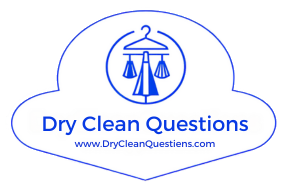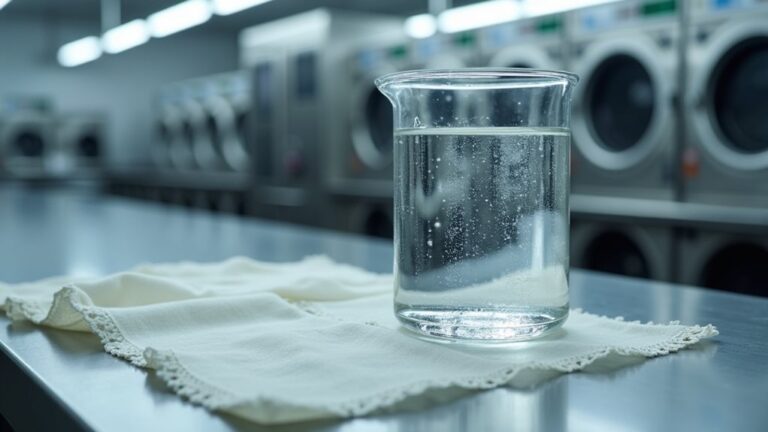Yes, dry cleaning absolutely kills viruses through its intense heat process that reaches 220°F during steaming and up to 325°F during pressing—temperatures that destroy viral proteins and render pathogens inactive on your clothes. I’ve learned that viruses like COVID-19 and influenza can survive on fabric for extended periods, but the combination of high heat and specialized chemical solvents in professional dry cleaning creates a thorough sanitization that’s more effective than home washing, which only reaches 140-150°F. Understanding the complete science behind this process reveals why it’s particularly essential for certain situations.
How High Temperatures in Dry Cleaning Eliminate Viruses
When I first wondered whether my favorite blazer would survive a virus encounter, I discovered that dry cleaning’s secret weapon isn’t just the solvents—it’s the incredible heat that transforms your local cleaner into a virus-eliminating powerhouse.
The incredible heat from dry cleaning transforms your local cleaner into a virus-eliminating powerhouse that goes beyond just solvents.
Those high temperatures you’ll experience during the steaming process reach up to 220°F, which means viruses don’t stand a chance against this thermal assault.
What really amazed me was learning that the pressing phase cranks things up even further, hitting between 300-325°F—hot enough to kill viruses while making your clothes look crisp and professional.
The entire dry cleaning process becomes this methodical, heat-driven campaign against pathogens, giving you confidence that your garments emerge both stylish and sanitized. 🔥
The combination of chemical solvents like perchloroethylene and these extreme temperatures creates an environment that’s particularly hostile to most pathogens, making dry cleaning highly effective at eliminating common germs and bacteria alongside viruses.
What Types of Viruses Can Survive on Clothing
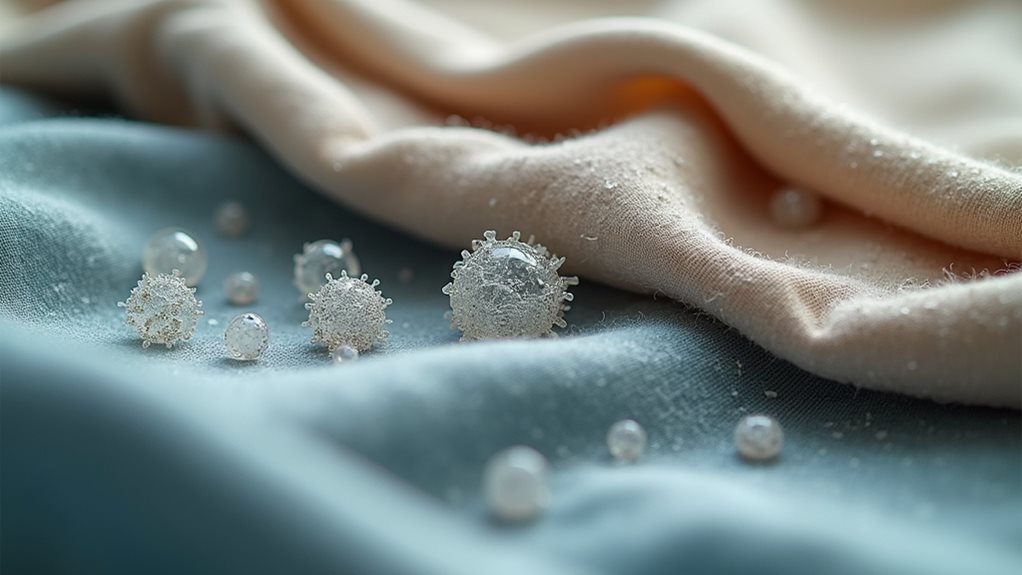
The invisible hitchhikers on your clothing create a fascinating, somewhat unsettling world that I never fully appreciated until I started researching which viruses actually make themselves at home on our favorite garments.
You’d be surprised how many common viruses can cling to fabric fibers, waiting patiently for their next opportunity. The influenza virus, for instance, can survive on clothing for extended periods, while the COVID-19 virus has shown remarkable persistence on various fabric types, though thankfully for shorter durations than on hard surfaces.
Understanding which viruses can survive helps you make informed decisions about when professional dry cleaning disinfect services become crucial, especially since these processes effectively kill bacteria and viruses that regular washing might miss.
While dry cleaning significantly reduces the microbial load on clothing through chemical solvents and heat, it may not eliminate extremely hardy spores or certain resilient viruses.
- Dense-weave fabrics trap viruses more effectively than loose materials
- Respiratory viruses like influenza show extended survival on clothing
- COVID-19 demonstrates moderate persistence on fabric surfaces
- Transmission through clothing remains less common than airborne spread
- Professional cleaning eliminates most viral contamination
The Science Behind Heat-Based Virus Destruction
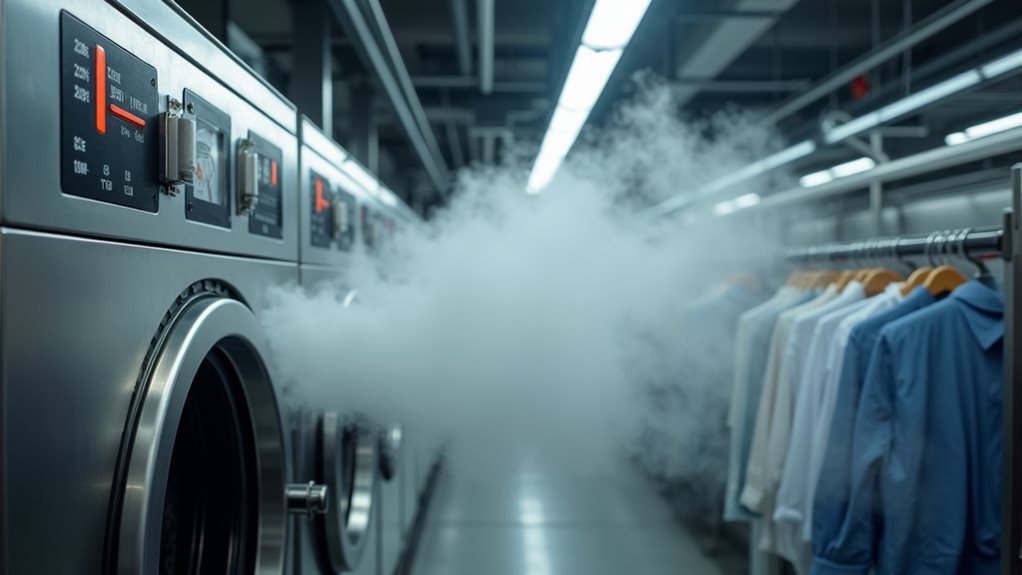
Now that you know which uninvited guests might be lurking on your clothes, let’s explore exactly how heat becomes their ultimate nemesis.
Honestly, the science behind this process feels like watching a microscopic action movie unfold. When dry cleaning services crank up those temperatures to 220°F during steaming, you’re witnessing viral proteins literally falling apart—imagine tiny molecular structures melting like ice cubes in hot coffee.
The heat drying process doesn’t just remove moisture; it systematically destroys the protective outer shells that viruses desperately need to survive. Within thirty minutes of exposure to these blazing temperatures, even stubborn pathogens like COVID-19 surrender completely.
While traditional dry cleaning uses perchloroethylene (PERC) as a chemical solvent, the high-heat processes involved provide an additional antimicrobial benefit beyond just cleaning.
It’s fascinating how something as simple as controlled heat can kill germs so effectively!
Comparing Dry Cleaning Vs Home Washing for Virus Removal
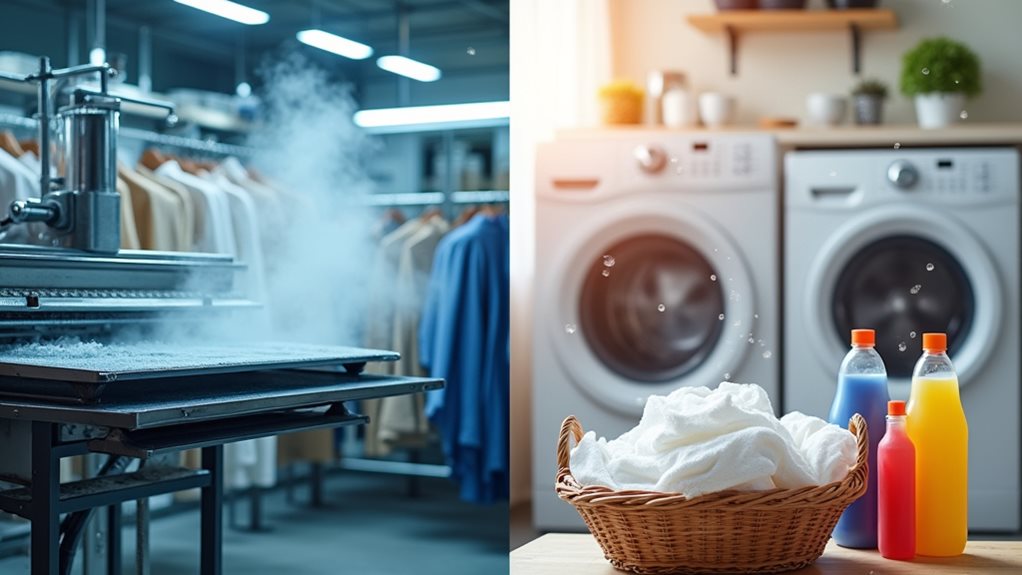
Although both methods can tackle viruses on your fabrics, you’ll discover some pretty dramatic differences when comparing dry cleaning to your trusty home washing machine, and honestly, it’s like comparing a precision surgical tool to a reliable kitchen knife—both work, but one’s definitely more specialized.
Dry cleaning operates like a precision surgical tool while home washing is your reliable kitchen knife—both effective, but one’s definitely more specialized.
When you’re washing your clothes at home, you’re fighting an uphill battle against temperature limitations, since most home machines can’t consistently reach those virus-killing temps of 140-150°F that really make germs and bacteria surrender.
Meanwhile, dry cleaning can kill viruses more effectively because it cranks up the heat to 220°F during steaming, plus those specialized solvents pack a serious punch against pathogens.
If you’re concerned about chemical exposure from traditional solvents like perchloroethylene, many cleaners now offer eco-friendly cleaning methods such as wet cleaning and CO2 cleaning that provide effective virus removal with reduced environmental impact.
- Higher temperatures in dry cleaning (220°F vs 140-150°F home washing)
- Specialized chemicals improve virus destruction beyond regular detergents
- Professional equipment guarantees consistent heat distribution throughout garments
- Delicate fabrics receive thorough cleaning without risk of damage
- “Dry Clean Only” items get proper virus removal while maintaining fabric integrity
Steam and Chemical Solvents: A Dual Defense Against Pathogens

When you’re wondering how dry cleaning actually eliminates viruses from your favorite blazer or delicate dress, the magic happens through a powerful one-two punch that would make any germaphobe smile 😊.
The steam reaches scorching temperatures of 220°F, which is hot enough to make most pathogens wave their white flags in surrender, while the chemical solvents work like tiny molecular warriors, breaking down and loosening any stubborn microbes that might be clinging to your fabric fibers.
This dual approach means you’re getting both the thermal destruction from intense heat and the chemical breakdown from specialized solvents, creating a sanitization process that’s frankly more thorough than what most of us can achieve with our home washing machines.
While your work uniforms and specialized clothing get this thorough cleaning treatment, remember that dry cleaning expenses for these items may be tax deductible if they’re required for work and unsuitable for everyday wear.
Steam Temperature Effectiveness
Since dry cleaning combines both intense heat and powerful chemical solvents, you’re getting what I like to call a “one-two punch” against viruses that would make any germaphobe smile with relief 😊.
The steam used in this process reaches an impressive 220 degrees Fahrenheit, which is hot enough to kill most viruses on contact, including those pesky ones that seem to stick around forever on fabric surfaces.
Here’s what makes steam temperature so effective:
- High heat disrupts viral protein structures, rendering them inactive
- Steam penetrates deep into fabric fibers where viruses hide
- The 220°F temperature exceeds most pathogens’ survival thresholds
- Combined with chemical solvents, creates inhospitable environment for germs
- Pressing stage adds extra protection at 300-325°F for complete elimination
However, it’s important to understand that dry cleaning’s primary purpose is to clean and preserve delicate fabrics rather than provide medical-grade sterilization for true disinfection.
Chemical Solvent Properties
While the scorching temperatures we just discussed pack a serious punch, the chemical solvents used in dry cleaning deserve their own spotlight because they’re working overtime to create what I’d describe as a hostile takeover of any virus trying to make your clothes its permanent home.
These specialized solvents, particularly perchloroethylene and newer eco-friendly alternatives, possess remarkable disinfecting capabilities that go beyond simple cleaning—they’re literally dissolving the protective barriers that keep pathogens alive.
Think of these chemical solvents as microscopic bouncer teams, breaking down the lipid membranes of viruses and bacteria while simultaneously lifting away dirt and oils.
When combined with those high temperatures, you’re getting a one-two punch that leaves virtually no chance for unwanted microscopic hitchhikers to survive the process.
The effectiveness of PERC solvents stems from their exceptional ability to remove oils and greases while penetrating delicate fabrics without causing damage, making them particularly lethal to pathogens that rely on lipid-based protective structures.
When to Choose Dry Cleaning for Maximum Sanitization
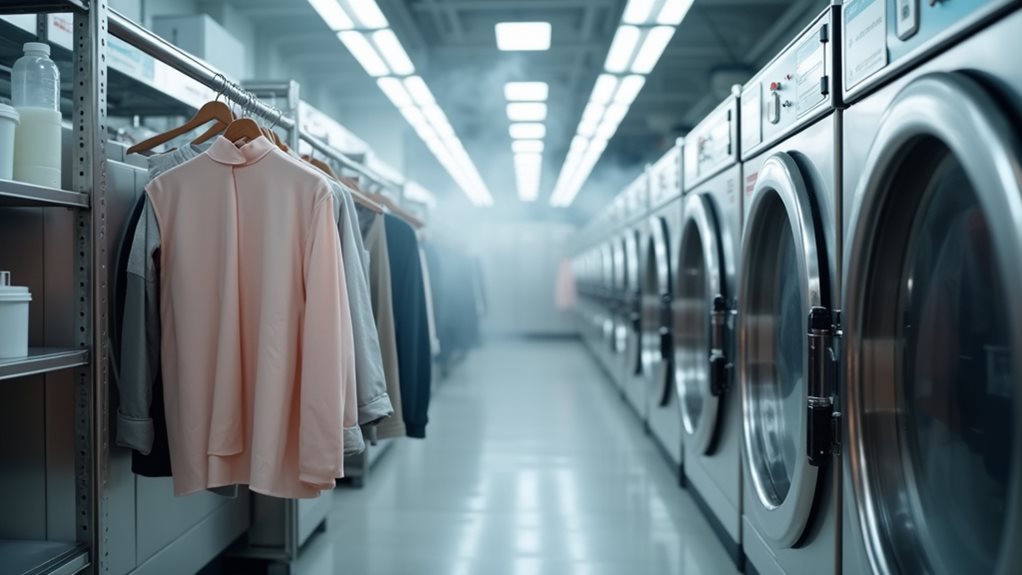
You’ll want to prioritize dry cleaning when you’ve been in crowded hospitals, busy airports, or other high-risk spaces where germs love to hitchhike on your clothes, because honestly, regular washing just can’t match those intense 325°F temperatures.
I’ve learned the hard way that delicate fabrics like silk blouses and wool suits actually benefit from this heat-intensive process, since throwing them in your home washer might shrink them but won’t necessarily kill stubborn viruses clinging to the fibers.
When you’re dealing with expensive garments that have been exposed to questionable environments, dry cleaning becomes your best friend for both preserving the fabric’s integrity and guaranteeing maximum sanitization through those powerful chemical solvents.
However, it’s important to allow freshly dry-cleaned items to air out before wearing them, since residual chemicals from the cleaning process can linger on clothing and potentially cause health concerns with direct skin contact.
High-Risk Contamination Scenarios
When you’re dealing with potentially contaminated clothing, there’s a fascinating parallel between how we handle our laundry and how we approach risk in life – sometimes the extra precaution really does make all the difference.
Think about those moments when you’ve been around sick family members, worked in healthcare settings, or spent time in crowded spaces during flu season – your clothes become silent carriers of invisible threats.
- Healthcare worker uniforms exposed to patient environments need professional-grade cleaning beyond home washing capabilities.
- Clothing worn during illness recovery requires thorough disinfection to prevent recontamination or spreading germs to others.
- Items from crowded events like concerts or conferences benefit from the superior sanitization that dry cleaning provides.
- Sports gear and gym clothes used in shared facilities where germs multiply rapidly on equipment and surfaces.
- Travel clothing from airports, hotels, and public transportation where countless people have touched the same surfaces you’ve encountered.
The Health Organization consistently emphasizes that proper cleaning protocols matter most when contamination risks run highest.
The chemical solvents used in dry cleaning have powerful antimicrobial properties that destroy bacteria, viruses, and fungi on contact, making this process particularly effective for high-risk contamination scenarios.
Temperature-Sensitive Fabric Care
Because delicate fabrics require such careful handling, you’re often faced with a choice between preserving your favorite garments and guaranteeing they’re properly sanitized – but here’s the beautiful thing about dry cleaning: you don’t have to choose.
The dry cleaning process works like a superhero for your silk blouses and wool sweaters, using specialized solvents that clean thoroughly while those scorching 200-220°F steaming temperatures obliterate bacteria and viruses without breaking a sweat.
I learned this the hard way after ruining my grandmother’s vintage silk scarf in regular wash – those “Dry Clean Only” labels aren’t just suggestions, they’re lifelines.
Unlike water-based washing, chemical solvents like perchloroethylene effectively remove oil-based stains and contaminants while maintaining the structural integrity of your garments.
Your temperature-sensitive fabrics get maximum sanitization plus preservation, because sometimes you really can have your cake and eat it too.
Professional Cleaning Standards for Virus Elimination
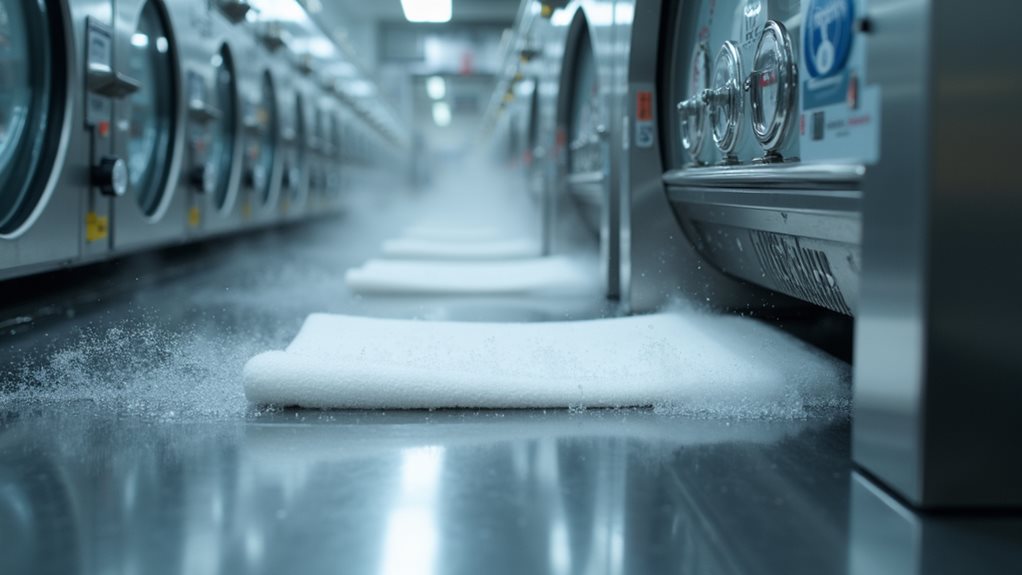
While most of us trust our local dry cleaner to remove stubborn stains and freshen our favorite garments, the professional cleaning industry actually operates under rigorous standards that make it surprisingly effective at eliminating viruses and other pathogens.
You’re probably amazed, like I was, to discover that professional cleaning establishments follow strict sanitization protocols that go far beyond what we achieve at home.
The dry cleaning process creates a hostile environment for viruses through multiple defense mechanisms:
- High-temperature steaming reaches 200-220°F, effectively destroying viral particles
- Commercial-grade solvents and detergents target pathogens specifically
- Multiple heat cycles guarantee thorough sanitization throughout garments
- Mechanical action during cleaning physically removes contaminants
- CDC-approved methods provide health authority validation
These extensive standards transform your neighborhood cleaner into a virus-fighting powerhouse.
